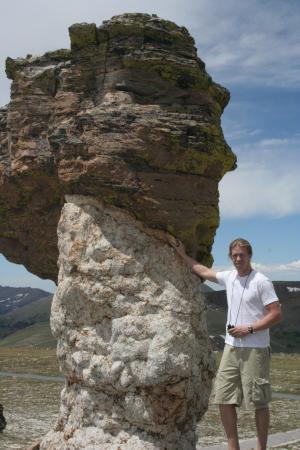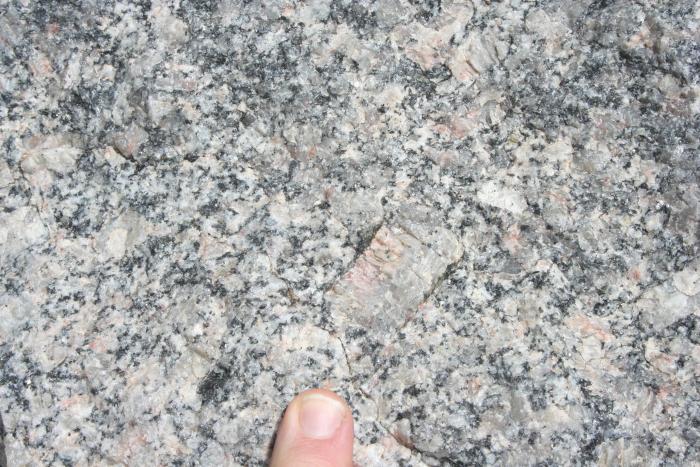Chemical Weathering
Chemical changes are often more interesting and more complex than physical ones. There is a great range of possible changes, and you must know a lot of chemistry to really appreciate all of them. In general, weak acids are the most important. (Strong acids would be most important, except nature doesn’t make large quantities of them!) Rainwater picks up carbon dioxide from the air and becomes a weak acid called carbonic acid. In soils, water may pick up more carbon dioxide plus organic acids from decaying organic material, becoming a slightly stronger but still-weak acid.
When acid attacks a rock, the results depend on what minerals are present, how warm, wet, and acidic the conditions are, and a few other things you don’t need to worry about. We can sketch some general patterns. Suppose we start with granite, a silica-rich rock that forms in many continental and island-arc settings. Granite is fairly common and contains a lot of the commonest elements in the Earth’s crust, so learning about granite gives you insights into weathering of other things. Don’t obsess about learning the details of the minerals we discuss; start by looking for the big picture.
In the image below, you see Penn State graduate Matt Spencer in front of white granite that was intruded into dark metamorphic rock, along Trail Ridge Road in Rocky Mountain National Park. The granite has weathered faster than the metamorphic rock in this environment, so the granite remains only where it is protected by the overhanging metamorphic rock. (These vaguely mushroom-shaped features are called "hoodoos", by the way.)

As shown in the close-up picture of a granite boulder below, granite usually is composed of four minerals: quartz (which is almost pure silica, with silica in turn composed of the elements silicon and oxygen), potassium feldspar and sodium-calcium feldspar (mostly silica, with a little aluminum replacing some of the silicon and potassium, sodium or calcium added for balance), and a dark silica-bearing mineral containing iron and magnesium (often a dark mica called biotite). The eight elements named in this paragraph make up almost 99% of the atoms in the rocks of the crust of the Earth. (Helping living things survive and running our economy requires many other elements that are quite rare in rocks, one reason that geologists are hired to find valuable, rare things and help mine them.)

When granite interacts with carbonic acid, several things happen. Typically, for most of the minerals in most environments:
- Iron (Fe) rusts. It picks up water and oxygen and remains in the soil as little pieces of rust.
- The aluminum (Al), potassium (K), and silica (SiO2) from the feldspars and from the dark mineral rearrange into new minerals, called clays, that also include some water.
- The calcium (Ca), sodium (Na), and magnesium (Mg) dissolve in water and wash away.
- Most of the quartz (silica as a mineral) sits there almost unchanged as quartz sand (a little of it may dissolve and wash away, but most stays).
One can write a sort of equation:
Granite → rust + clay + (dissolved-and-washed-away Ca + Na + Mg) + quartz sand
The rust, sand, and clay left behind, plus a little organic material often including worm poop, become the indispensable layer we know as soil. (And, if you have ever tried to drive a car on soft soil during a rainstorm and had your tires sink in and get stuck, you may call the soil “mud”, possibly with some bad words added.)
The calcium and silica that dissolve and wash into the ocean are used by sea creatures to make shells, the dissolved magnesium washed into the ocean often ends up reacting with hot rocks at spreading ridges to make new minerals in the seafloor or goes into some of the shells, and the dissolved sodium accumulates in the ocean to make it salty. (Eventually, the ocean loses some salt, often by the salty water getting trapped in spaces in sea-floor sediments and going down subduction zones to feed volcanoes; evaporation of water in restricted basins also may cause deposition of some salt.)
You should recognize that this is a very general description of what happens; were it this easy, there would not be hundreds of soil scientists working to understand this important layer in which most of our food grows. In general, the hotter and wetter the climate, the more stuff is removed—rust and quartz sand can be dissolved in some tropical soils, leaving aluminum compounds that we mine for use in making aluminum. In dryland soils, calcium and magnesium may be left behind forming special desert soils, or sodium may be left behind forming salty soils in which little or nothing will grow.
You also should recognize that the “chunks” in soil – rust, clay, sand, and organic materials – can be carried away by streams or wind, or glaciers, but as chunks rather than invisible dissolved materials. We discuss this loss of chunks in the next sections. If chunks are carried away more rapidly than new ones are formed, the soil will thin, and we will find it difficult to grow food to feed ourselves (this is what Teddy Roosevelt worried about in the quote at the start of this Module). The chunks eventually are carried to the oceans and deposited as sediment on the seafloor, together with a lot of shells.
Recycling
Granite may form beneath a volcano in a subduction zone. We have just seen that the granite then will begin to break down, making dissolved things and chunks. Eventually, the chunks are carried to the sea, by rivers and glaciers and wind (we will study this transport soon), while the dissolved things also go to the sea where they are turned into shells or other things. Sediment consisting of these chunks and shells, with some of the salty water in the spaces, is then taken down subduction zones to feed volcanoes that make granite. Some of the shells even contain a little carbon, and some dead things containing carbon are buried in the sediments, and some of this carbon is taken down subduction zones and supplies carbon dioxide to the volcanoes with water, helping make carbonic acid that weathers the granite.
If this looks like a cycle, it is! The Earth really does cycle, and recycle, everything! But, going around this loop once takes at least millions of years, and may take a lot longer than that, issues we'll discuss later.